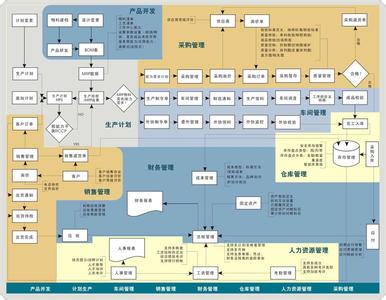ERP是Enterprise Resource Planning(企业资源计划)的简称,是上个世纪90年代美国一家IT公司根据当时计算机信息、IT技术发展及企业对供应链管理的需求,预测在今后信息时代企业管理信息系统的发展趋势和即将发生变革,而提出了这个概念。接下来小编为大家整理ERP的介绍,希望对你有帮助哦!
Enterprise resource planning systems (ERPs) are management information systems that integrate and automate many of the business practices associated with the operations or production aspects of a company. Contents
OverviewEnterprise resource planning is a term derived from manufacturing resource planning (MRP II) that followed material requirements planning (MRP). ERP systems typically handle the manufacturing, logistics, distribution, inventory, shipping, invoicing, and accounting for a company. Enterprise Resource Planning or ERP software can aid in the control of many business activities, like sales, delivery, billing, production, inventory management, and human resources management.
ERPs are often called back office systems indicating that customers and the general public are not directly involved. This is contrasted with front office systems like customer relationship management (CRM) systems that deal directly with the customers, or the eBusiness systems such as eCommerce, eGoverment, eTelecom, and eFinance, or supplier relationship management (SRM) systems that deal with the suppliers.

ERPs are cross-functional and enterprise wide. All functional departments that are involved in operations or production are integrated in one system. In addition to manufacturing, warehousing, logistics, and Information Technology, this would include accounting, human resources, marketing, and strategic management.
In the early days of business computing, companies used to write their own software to control their business processes. This is an expensive approach. Since many of these processes occur in common across various types of businesses, common reusable software may provide cost-effective alternatives to custom software. Thus some ERP software caters to a wide range of industries from service sectors like software vendors and hospitals to manufacturing industries and even to government departments.
ImplementationBecause of their wide scope of application within the firm, ERP software systems rely on some of the largest bodies of software ever written. Implementing such a complex and huge software system in a company usually involves an army of analysts, programmers, and users, and often comprises a very expensive project in itself for bigger companies, especially transnationals.
Enterprise resource planning systems are often closely tied to supply chain management and logistics automation systems. Supply chain management software can extend the ERP system to include links with suppliers.
To implement ERP systems, companies often seek the help of an ERP vendor or of third-party consulting companies. Consulting in ERP involves two levels, namely business consulting and technical consulting. A business consultant studies an organization's current business processes and matches them to the corresponding processes in the ERP system, thus 'configuring' the ERP system to the organisation's needs. Technical consulting often involves programming. Most ERP vendors allow changing their software to suit the business needs of their customer. But customizing an ERP package is very expensive and complicated, so most businesses implement the best practices embedded in the acquired ERP system.
Today there are also web-based ERP systems. Companies would deploy web-based ERP because it requires no client side installation, and is cross-platform and maintained centrally. As long as you have an Internet connection, you can access web-based ERPs through typical web browsers.
DisadvantagesThere can be limitations and pitfalls to ERP, though:
the systems are usually expensive to install and maintain
ERPs are often seen as too rigid, and difficult to adapt to the specific Workflow and Business process of some companies——this is cited as one of the main causes of their failure.
some systems can be difficult to use
the system can suffer from the "weakest link" problem - an inefficiency in one department or at one of the partners may affect other participants
once a system is established, switching cost are very high for any one of the partners (reducing flexibility and strategic control at the corporate level)
the blurring of company boundaries can cause problems in accountability, lines of responsibility, and employee morale
a natural resistance to sharing sensitive internal information between departments can reduce the effectiveness of the software
there are frequent compatibility problems with the various legacy systems of the partners
the system may be over-engineered relative to the actual needs of the customer
 爱华网
爱华网



